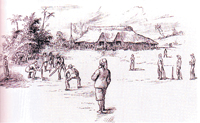Early days of cricket The earliest mention of a cricket club in Ceylon dates back to August 8, 1832, identified as the date on which the 'Cricket Club' was established. But due to lack of old records, there is hardly any information of its progress in the years that followed.
In the late 1860s, however, the Colombo Cricket Club comes into prominence. Several other clubs are also mentioned by 1869. The Union Club, the Smallpass Club, the Slave Island Club, the Juvenile Graduates, the Hultsdorf Club, the Fort Club and the Military Club are among those. The match between Colombo and Up-country has been the principal match in the early days of cricket in the country dating back to the early 1860s. Expatriates, really Englishmen, were the players of both teams. Details of the match played in 1875 have been recorded. Only one innings per side was played and Colombo won, the scores being Colombo 99 and Up-country 43. For Colombo, Captain Budgeon scored 48. 'The Illustrated Sports and Dramatic News' (October 1878) published in England recorded that a match played at Kadapolla was "an immense treat". "Badulla men had to journey from 40 to 50 miles across country to get to the ground, and that by many this distance was accomplished by foot", the report states.
A bank is inaugurated The Ceylon Savings Bank was established on August 6, 1832 obviously to promote the savings habit among the people. A government institution, it was managed by a Board of Directors under an Ordinance. Steady progress was made in the early years and soon the Bank developed into a recognised financial institution. The earliest mention of a bank in Ceylon is a private institution established by Jeronis Pieris and Louis Pieris in Kandy in 1828. Reference is made to this bank -'The Bank of Kandy' - by Sir Thomas Villiers in his book, 'Mercantile Lore'. He writes: "It was in the early days of coffee, and money was always in demand. Colombo was very far away, taking no less than four days to reach from the hill capital. The road too led through robber-infested country, and was consequently never safe. Sardiel, Ceylon's Robin Hood was only one of the many who made the cart road a danger. There were bands of highwaymen, not to mention rogue elephants and other savage animals, reported all along the less frequented paths. So it came about that the Kandy Bank became a most useful institution, keeping money in custody till called for, and furnishing money on Colombo orders, when getting money from Colombo was a very hazardous business."
Gas lights in Colombo city Colombo city is well lit up today. But for most part of the 19th century it was not so - at least not until August 5, 1872 when gas lamps were used for lighting of Colombo. The supply of gas was done by Colombo Gas & Water Company which was formed in 1868. In the following year, the company entered into an agreement with the Colombo Municipal Council. By the end of the first year, there were 870 gas lamps in the streets. The cost of service was estimated at Rs 70,000. The supply of electricity for lighting the City started after a private company, Boustead Brothers commenced the generation of electricity on commercial lines in 1895. This was done following concessionary terms offered by the Colombo Municipal Council for a tramways scheme. Power was first supplied to the Fort area and a few government offices. In 1927 the Government bought the electricity system from Boustead Brothers and set up the Government Electrical Department. A library in Colombo The first library in Colombo was founded on August 12, 1813. It was called 'The United Service Library' and at first was solely for the use of civil and military officers of the Government stationed in Colombo. It was housed in a military building opposite Queen's House (now President's House) which was demolished when the General Post Office was built. Later the members who were elected had to pay subscriptions to use the library. The 'Colombo Pettah Library' was the second library in Colombo. It was established by the Burgher community in the City. Pettah was then the residential area of the Burghers. They had moved over from the Fort when that area became too busy. |
||||||
Copyright © 2006 Wijeya Newspapers
Ltd. All rights reserved. |
